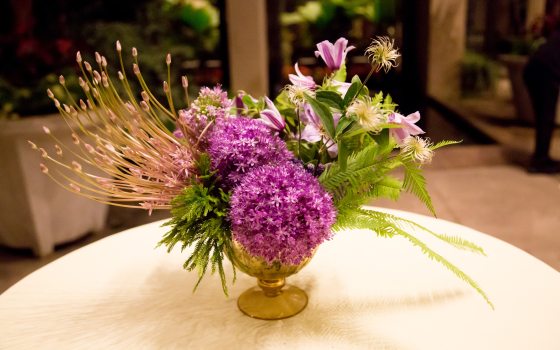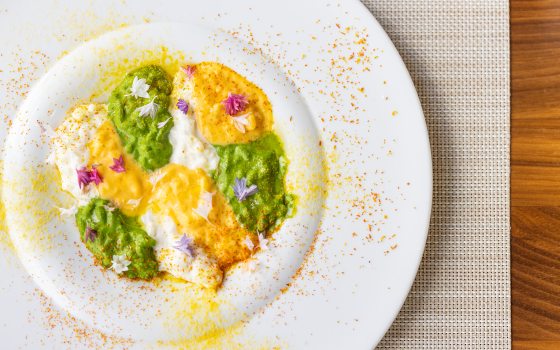At Longwood, our horticultural vision combines art and science in novel and inspiring ways, resulting in blooms of every shape, size, and color throughout the seasons—think endless hydrangeas varieties, to lilies of any color, to much more. Recently, that vision has extended beyond garden beds with the design and display of cut flower arrangements. Found in such spaces as the Visitor Center, by the Guest Services desk in the Main Conservatory, or in the conservatory of the Peirce-du Pont House, our arrangements take their cues from the seasons and are styled in natural ways to highlight their connections to the Gardens. Right now, we’re focusing on summer blooms with admirable visual qualities like texture and color in our arrangements—and you can do the same at home.
When we create our cut flower arrangements, we use inspiration from our magnificent garden spaces—sometimes, we even create arrangements that serve as condensed variations of the garden itself. Just the other day, for example, a small cluster of blue flowers paired with burgundy foliage in the Idea Garden inspired an entire arrangement for the Visitor Center that featured purple Allium, Calendula, and iris with copper beech and burgundy Dracaena.
As Longwood’s Associate Director of Floral Design, Longwood has long been my muse, initially inspiring me to explore the world of horticulture more than 20 years ago. After owning my own flower design studio and working for Biltmore Estate in North Carolina, I now find myself scanning the Gardens daily for different branches, leaves, flowers and more to use in arrangements.
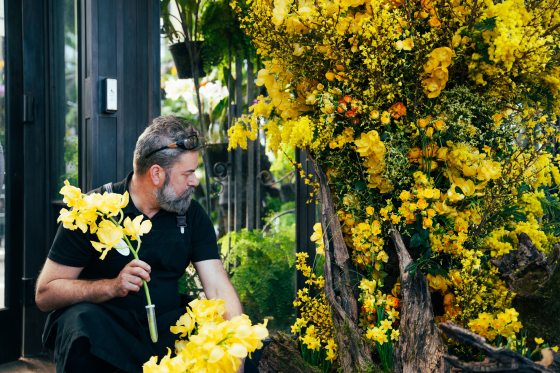
We were delighted to bring arrangements to new heights this past February with this 15-foot-tall, towering, twisting arrangement in an explosion of yellow hues of Acacia decurrens, orchids, roses, forsythia, and more, which swirled up toward the sky outside the Orchid House. Photo by Holden Barnes.
My floral design journey has taught me to look at arrangements with new eyes, while seeing the beauty in each bloom, stem, and the layers that form the foundation of any arrangement. This summer, Longwood is utilizing texture and color to give our arrangements interest. And while you won’t see wildly opposing colors, these arrangements embody elegance by working within a color field; perhaps a dainty lady’s-mantle with a chartreuse hue is paired with dramatic hosta leaves, as one example.
Our floral arrangements are modern in shape and concept—and that extends to the vessel that holds the arrangement as well. When designing in containers, I always make sure some of the blooms “break” the container, meaning the blooms nod down to soften the hard edge of the container. Because the container is the breathing space between the table and the arrangement, you want to bridge that space with flowers and greenery.
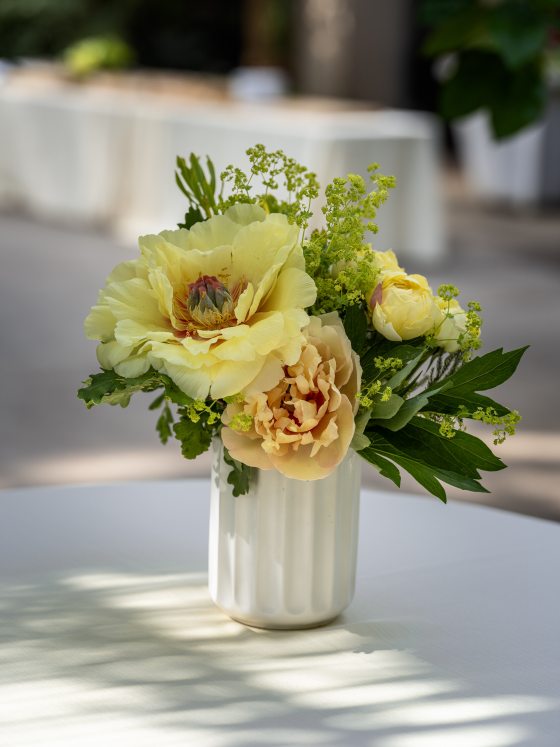
Notice how this arrangement is off-balance and the greenery breaks the container. The overall effect of the arrangement is striking with its brightly colored blooms and foliage that breaks the hard lines of the container. Photo by David Ward.
Another point of beauty to look for is the balance of the arrangement. A flower arranging style you’ll notice amongst pieces at Longwood is that they tend to be a little off balance. Floral arrangements shouldn’t be too rigid in my opinion. Follow the cues of nature, stagger stems from heavy to light, and finish with wisps of flowers like freesia.
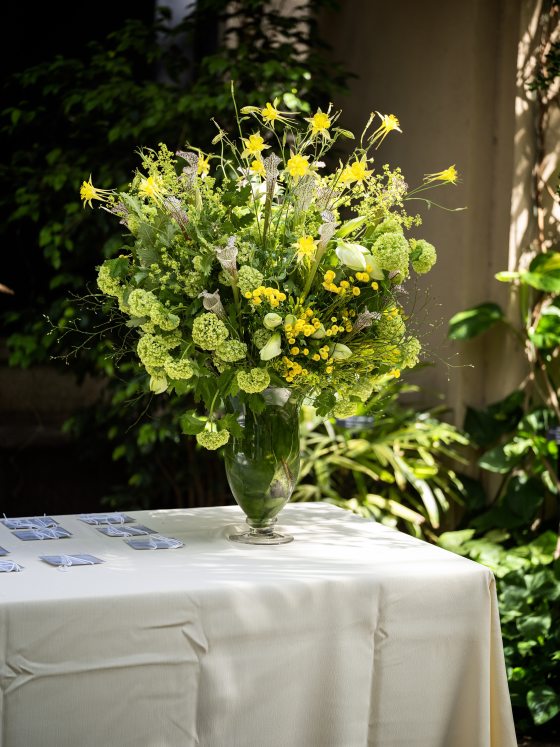
Seasonal viburnum combine with pitcher-plants and bright yellow columbine in this arrangement that follows a color palette. Photo by David Ward.
If you’re feeling inspired after admiring the beauty of our Gardens and floral arrangements, try your hand at your own arrangements at home! While there are so many flowers to choose from, here are a few we are showcasing at Longwood this season.
We’ve recently used snowball viburnum in our arrangements and luckily we can continue to keep using viburnum in our floral arrangements all year. This deciduous shrub sprouts many branches in spring covered with white to green “snowballs.” The round bloom is easily confused with hydrangea, though they hang in floppy clusters from the branches. In summer, blooms give way to luscious garnet-colored berries that are also a fabulous addition to arrangements. As if that wasn’t enough, the foliage in fall turns a beautiful crimson color.
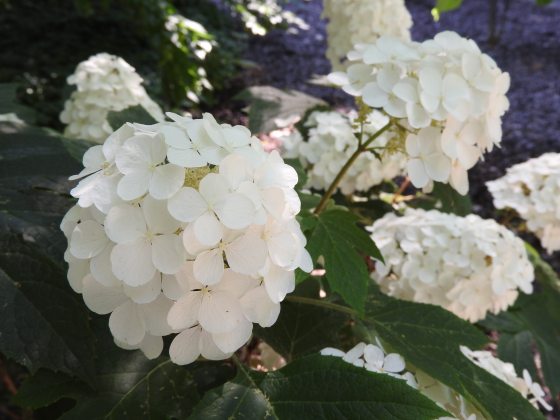
Hydrangea quercifolia 'Flemygea '. Photo by Cathy Matos.
Speaking of hydrangeas, these blooms also make for exceptional arrangements by themselves or as an addition to any composition. Their big heads, made up of much smaller blooms, can be round or conical depending on the variety. Hydrangea macrophylla, or bigleaf hydrangeas, are best known for their colorful heads throughout the summer and on in shades of pink, blue, purple, and red. The oakleaf, smooth, and silver-leaved hydrangeas each bring their own benefits of beauty and function. The conical varieties of Hydrangea paniculata, are mostly whites, creams, and greens.
If you’re looking to plant hydrangeas, know that they enjoy sun but will burn in hot afternoon sun. They also need a good amount of water and well-draining soil. Zones 5 through 9 are best for them. Hydrangeas can last a long time when the stem is cut under water when arranging. They can also be resuscitated if they wilt by soaking them in a sink of cool water for 15 minutes and recutting the stems, placing the stem in warm water and waiting. Make sure to keep them away from sunlight once cut.
With summer now here, flowers that bloom consistently throughout the warm months are a delight, and a continual source of new uses within arrangements. Take echinacea for example; this native perennial makes a terrific cut flower. With their dramatic cones and backward leaning petals, they add a sturdy line to any arrangement. They hold up beautifully as a cut flower and their cones also look great when dried. Reds, yellows, oranges, pinks, greens, doubles, singles—there’s a kaleidoscope of available colors and textures, one prettier than the next.
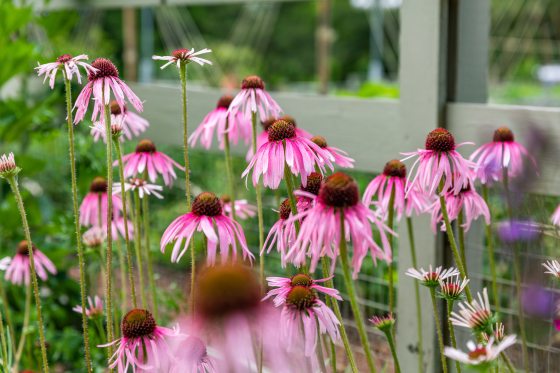
Echinacea pallida stun in the garden and as cut flowers for floral arrangements. Photo by Becca Mathias.
With big blousy blooms and heavenly fragrances, peonies make for beautiful cut flowers. They are stunning additions to any bouquet and are available in colors ranging from dreamy whites and creams to pale pinks and bold reds, fuchsias. They’re easy to grow and will provide gardeners with many luscious blooms year after year. Peonies bloom in late spring and early summer, though you can extend your season by finding varieties to grow that are late bloomers. If you have peonies in your yard, cut them when the buds are showing color but have not yet opened to enjoy a week of beautiful peonies once they unfurl (longer if you re-cut the stems occasionally). If you’re thinking you want peonies for next year, plant them in a sunny spot with well-draining soil this fall. Peonies grow well in zones 3 through 7, but the woody stemmed tree peony does well all the way to zone 9.
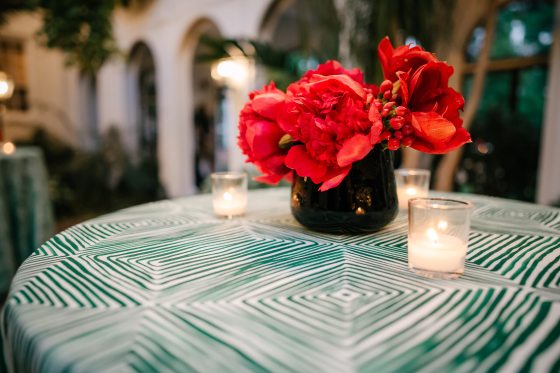
A simple arrangement in one hue brings complexity with texture, berries, and shape. This red arrangement includes Paeonia ‘Command Performance’, Hippeastrum ‘Ferrari’, and Hypericum ‘Royal Red’ berries. Photo by Laurie Carrozzino.
The globe-like purple blooms of ornamental onions (Allium) captivate in both gardens and arrangements. These statuesque plants are compact enough to fit in practically any garden space and also make for attractive dried flowers. In addition to their starry blooms, these plants do double duty in the garden—they’re resistant to deer, tolerant of drought and dry soils, and loved by pollinators. Plant Allium bulbs in fall in a spot where they’ll get full sun and then watch them grow and multiply for years to come.
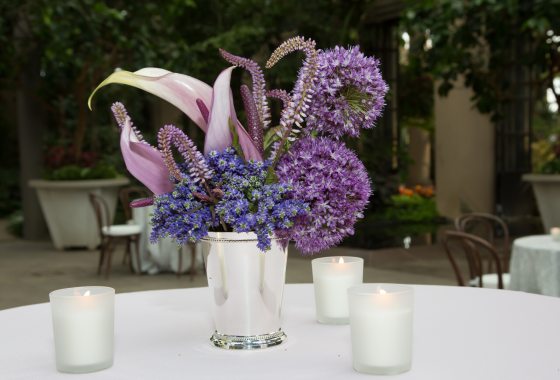
Using a palette of purples, this arrangement includes Anthurium ‘Previa’, Veronicastrum ‘Apollo’, Veronica Smart Fountain, and Allium ‘Ambassador’. Photo by Dave Shoemaker.
Not to be underestimated, greenery or foliage is an essential part of floral design—it can be just as worthy as the flowers. Hostas, grasses, evergreens, and other foliage all add interest to arrangements. Coralbells (Heuchera) are especially great for small arrangements. They thrive in the shade and make for long-lasting cut flowers. Their little pillows of foliage, usually only 8 to 12 inches tall, come in a rainbow of colors. And their delicate flowers hang like their namesake—bells off arching stems. It is hard to decide which is more useful for flower arrangements, the foliage or the flowers. They start producing blooms in June and continue through fall.
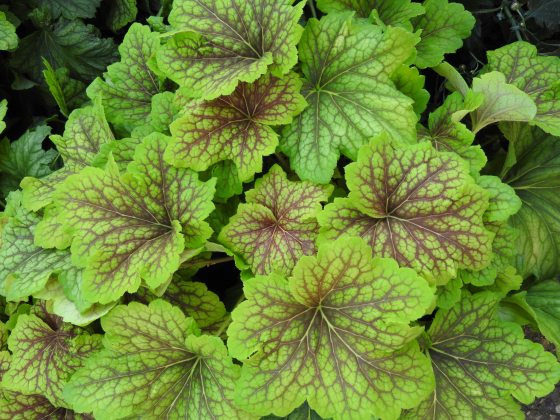
Worthy of a foliage feature, Heuchera, are available in a variety of colors, textures, and shapes. The vivid red veins of Heuchera 'Red Lightning,' are stunning just on their own. Photo by Cathy Matos.
On your next visit, see if you can spot our-ever changing arrangements. While you’re here, take a close look at their color, their texture, their relationship with their vessel, and their relationship with their surrounding space—and envision what you could do at home with your own arrangements.
